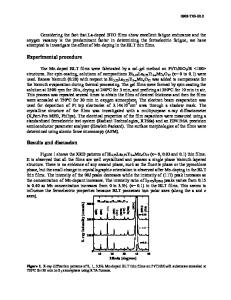Electrical and Dielectric properties of Bi 6 Mn 2 Ti 3 O 18
- PDF / 980,446 Bytes
- 6 Pages / 612 x 792 pts (letter) Page_size
- 58 Downloads / 425 Views
DD11.19.1
Electrical and Dielectric properties of Bi6Mn2Ti3O18 Suryanarayana S.V, Suresh M.B, Srinivas K, Venkata Ramana E and Swaminathan G1 Materials Research Lab, Physics Department, Osmania University, Hyderabad, India-500 007 1 BHEL R&D, Hyderabad, India ABSTRACT Bismuth layer structured ferroelectrics show interesting physical property variations as a function of external parameters viz., temperature, frequency and magnetic field. In some of these materials, when a magnetic ion is incorporated in the lattice, they show simultaneous ferroelectricity and magnetism, thus exhibiting magnetoelectric output under the influence of an external magnetic field. This paper reports the synthesis and characterization of Bi6Mn2Ti3O18(BMT) which is isomorphous with Bi6Fe2Ti3O18(BFT). The material was prepared both by solid state and microwave sintering routes. The characterization includes X-ray, SEM, conductivity, dielectric constant and pyroelectric coefficient. The results are compared with Fe containing analogue. INTRODUCTION Materials with multifunctional behaviour are of interest for device applications. It has been reported that a family of Bismuth layer structured ferroelectrics (BLSF) with a general formula of (Bi2O2)2+(An-1BnO3n+1 )2- where A is a mono, di- and trivalent ion or a mixture of them and B representing Fe3+,Ti4+,Nb5+,Ta5+,W6+ etc., and n taking any of values from 3 to 8 show interesting physical properties [1]. The temperatures of ferroelectric phase transition of these layer type ferroelectrics depend on the nature and concentration of A and B cations in the lattice [2]. Some of these materials incorporating Ti and Fe ions in the lattice are found to show simultaneous existence of ferroelectric and magnetic ordering [3]. Such materials are being explored for several applications because of their unique properties such as low dielectric constant, high Curie temperature, broadband frequency response and larger anisotropy in coupling factors [4]. Among the BLSF materials, Bi5FeTi3O15, Bi6Fe2Ti3O18, Bi7Fe3Ti3O21, Bi8Fe4Ti3O24 and Bi9Fe5Ti3O27 are found to show high Curie temperatures than the usual piezo-ceramics such as PZT, BaTiO3 and their solid solutions [5-7]. When a divalent or trivalent ions were substituted at A-site, not much appreciable decrease in transition temperatures was detected [8]. In the fourlayered compound Bi5FeTi3O15 the dielectric transitions are reported at 580oC and 750oC[6]. Interestingly when Mn is replaced for Fe in this material the resulting four-layered compound Bi5MnTi3O15 has shown dielectric transitions at 283oC and 316oC[9]. In the case of Bi6Fe2Ti3O18 the dielectric transition occurred at 805oC[5]. Hence it is intuitively expected that if Mn is replaced in this five layered compound there will be a drastic decrease in the transition temperature and also marked changes in other electrical and dielectric properties too. The variations may also be due to the fact of the concentration of Mn being 25% in the four-layered compound and 40% in the five-layered compound per unit
Data Loading...











